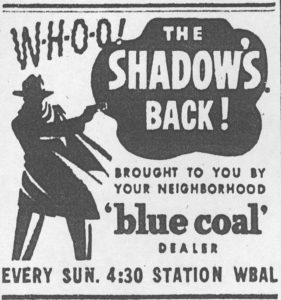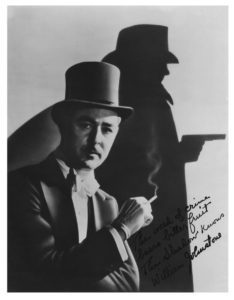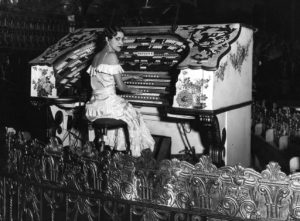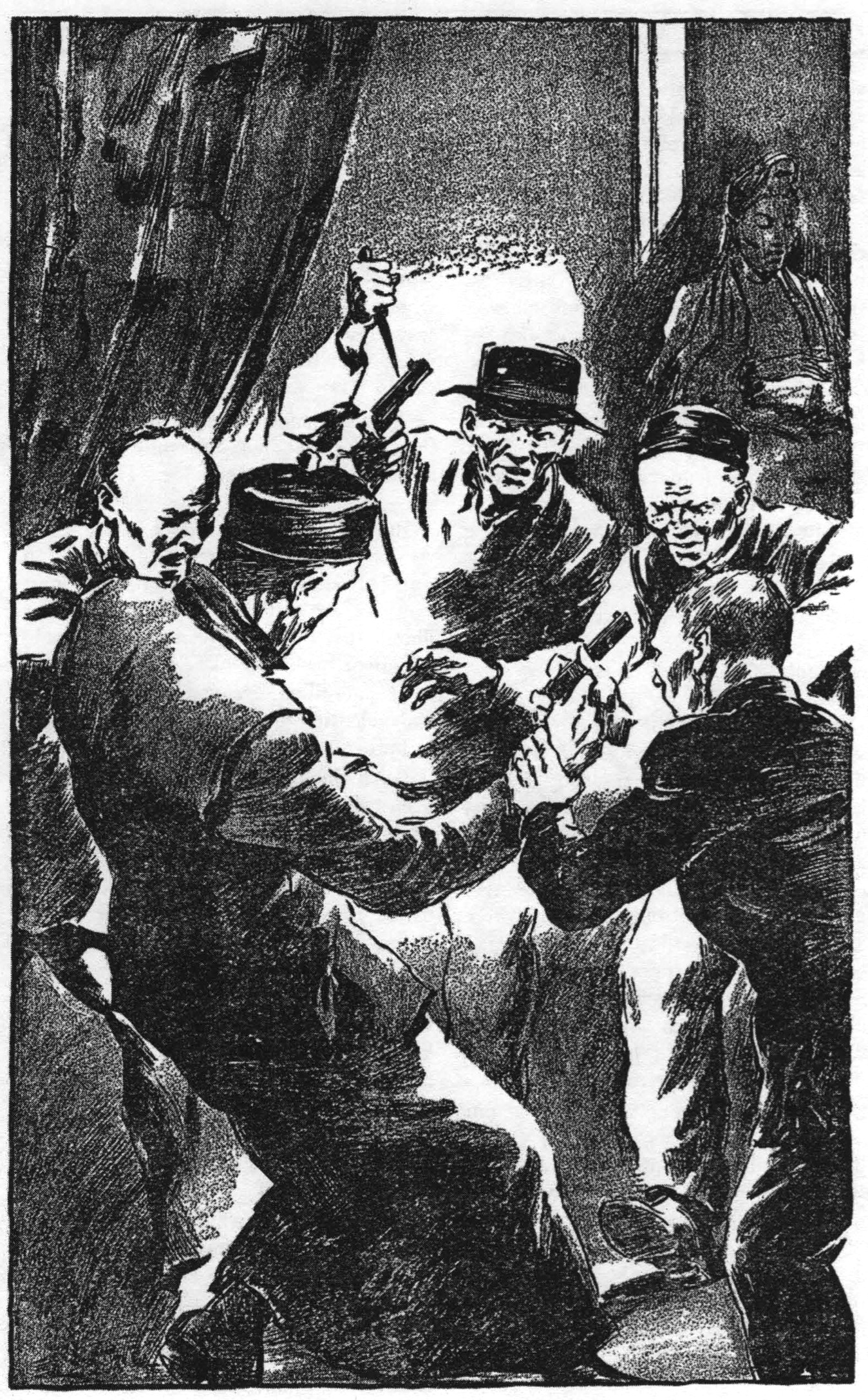
My favorite pulp character is undoubtedly The Shadow. It was The Shadow who first introduced me to the world of pulpdom. I was twelve years old and I heard The Shadow on the radio. These were rebroadcasts of the old series that KEX-AM in Portland, Ore., had purchased from syndicator Charles Michelson. Our family had just bought an open-reel tape recorder from Sears, and I immediately started recording The Shadow so I could listen to those amazing adventures over and over. Yes, obsessions start young.
As the years passed, I purchased and traded for tapes of The Shadow, always seeking a show I hadn’t heard before… always trying to find a better quality copy of an episode I already had. Today the tapes have been replaced by digital copies, and I’m happy to report that I have about 220 episodes of The Shadow… every one that I know to exist.
Sadly, there are another 400-500 “lost” episodes… radio broadcasts for which there are no known surviving recordings. But let’s not dwell on that now. That’s the subject for a future blog entry… and it definitely will be! For now, let’s focus on the recordings which have survived.
A quick comment about the commercials. In the East, The Shadow was sponsored by Blue Coal. The Blue Coal commercials are an important part of the listening experience. They help put the half-hour broadcast in perspective. They give it a historical context that adds to the general atmosphere of the program. Naturally the original commercials were excised when it was syndicated for rebroadcast in the 1960s, but I have sought out the original recordings with the original commercials wherever I could. The old recordings I made have been replaced by better, and more complete, copies.
I should also offer a brief explanation on Margo Lane, The Shadow’s aide and companion. Note I spell it “Margo” not “Margot.” That’s intentional, even though it was spelled Margot in all the radio scripts. My reasoning is that the “t” was never pronounced on the radio, so when I was listening to those rebroadcasts as a young lad I assumed it was spelled Margo. When I started reading the pulp stories, her name was also spelled Margo. The only place where it was spelled Margot was in the actual broadcast scripts… and only a dozen or so people ever saw them. So I prefer to spell her name as millions of radio listeners heard it, and as pulp audiences read it. That’s my choice and I’m sticking to it!
Who played The Shadow
The Shadow was portrayed by different actors over the years. Beginning in 1937 it was a young Orson Welles in the role. The following season, William Johnstone assumed the part. Then Bret Morrison, then John Archer, and then Morrison returned to play radio’s invisible crimefighter until the series left the air in 1954. Oh, and there was a brief eight-week stint in 1945 where Stephen Courtleigh played The Shadow. No recordings of his performances have survived, and I consider him a minor footnote in Shadow radio history.

Of all the actors who played the part, I consider William Johnstone to be my favorite. That may be heresy to some, who consider Orson Welles to be the ultimate Shadow, but I always found his acting to be too Shakespearean. And the fact that he never attended rehearsals (something he bragged about) was painfully obvious in his performances. William Johnstone’s voice added a maturity and gravity to The Shadow. Bret Morrison’s voice was quite good as well, and his younger tone suited the “wealthy young man about town” role of Lamont Cranston. But when I hear the voice of The Shadow in my mind, it’s the voice of Bill Johnstone that I hear.
Of all The Shadow recordings which still exist, my favorite is “The Ghost of Captain Bayloe.” Hands down. It fairly screams pulp, with its crazed scientist and his ray machines. This was in Charles Michelson’s syndicated package of 52 episodes sent around to radio stations in the early 1960s, and it made an indelible impression upon this 12-year-old boy. It still creates a surprising impact on me today, and I’m happy to say I have upgraded the quality of the recording, and it’s now complete with the original commercials.
The Ghost of Captain Bayloe
“The Ghost of Captain Bayloe” was originally broadcast over radio station WOR Mutual on Feb. 5, 1939. The opening organ music, Glooms of Fate, swells as organist Rosa Rio‘s fingers glide across the keyboard. And the unmistakable voice of Bill Johnstone intones the words that will be etched in my very soul until my dying day: “Who knows… what evil… lurks… in the hearts of men? The Shadow knows!” And then that laugh that reached its cold fingers down into the pit of my stomach… the quivery laugh of The Shadow.
After a brief announcement for your local Blue Coal dealer, today’s drama begins. Lamont Cranston, Margo Lane and wealthy ship-owner Commodore Ware are visiting the waterfront district to meet with the mate of the Northern Queen… the sole survivor after the ship went down. The sound man in the radio studio really takes you there with those gravelly footsteps that have a slight hollow sound, and the mournful hoot of the ships in the river. You can feel the clammy tendrils of fog swirling around you.
The three of them enter a waterfront saloon with its rough crowd and honky-tonk piano playing in the background. In a back room, they meet with the mate of the Northern Queen and he tells his story. It was the ghost of Captain Bayloe who steered the ship onto the rocks! Or so he claims. And who was this Captain Bayloe? The mate’s retelling of the old legend is accompanied by sound effect which brought chills to my spine.
The legend
‘Captain Bayloe’s been dead these 20 years or more. He was the last of the old square-rigger skippers. It was the China trade, he was in. On his last voyage out of the Orient, he carried two precious cargos: a shipment of silver and his beautiful young wife.
‘Captain Bayloe was quittin’ the sea to settle in South America. A happy pair, they were, sir. None happier. His crew, though, was the motliest collection of sea-scum to ever sail before the mast.’
‘Well, sir, they were just off the island that’s now called after him. Captain Bayloe was at the wheel, his wife beside him. The sea spray was washing her lovely face and she was laughing into the wind. The crew was aft, heads together, plotting mutiny. They wanted the silver… and the woman.
‘While the happy bride laughed beside the contented man, the crew crept slowly toward the bridge. Her laugh was cut short by the sight of the hard-faced men. Captain Bayloe asked them what they wanted for. They wanted the key to his cabin. He ordered the men below, but they balked. He reminded them it was mutiny.
‘Captain Bayloe told them they would get the key over his dead body. The men attacked like hungry wolves while Captain Bayloe’s wife stood frozen in horror. A blow from a belaying pin stunned the skipper. He fell to the deck. The crew were on him, snapping like a bunch of jackals.
‘Captain Bayloe was half-conscious when they threw him over the rail. He revived a bit when his body hit the water. He saw his ship with his wife aboard sailing away. Above the surge of the sea, he heard coming back on the wind the pitiful wail of his lovely wife.
‘Before the waters covered him up, Captain Bayloe, with an oath on his lips, swore eternal vengeance upon all men who sailed the sea. Captain Bayloe’s wife died soon after that. But he’s had his revenge many times over. He takes the helm of any ship that ventures into the waters where he lost his life and steers it onto the rocks of Bayloe Island.’
‘Why are you so sure the ghost of Captain Bayloe took command?’ Cranston asks.
‘Because I heard the warning. I was just going off watch when I heard it as plain as I hear you. The pitiful wail of Captain Bayloe’s wife. I knew then that the Northern Queen was done for. Another seaman and myself put a small boat over the side and rowed away. The other man died from exposure. I was picked up five days later by a liner.
Whew! What a legend.
Off to Bayloe Island
Before you know it, Cranston, Margo, Commodore Ware and the mate Andrews are off for Bayloe Island on Cranston’s yacht. They are determined to find the truth behind the ghost tale of Captain Bayloe.
When the crew finds out they are in the haunted waters off Bayloe Island, they panic. The ghostly wail of the woman… Captain Bayloe’s dead wife… comes across the waves. And then the engines of the yacht stop — held in the supernatural grasp of Captain Bayloe. The drifting tide draws them inexorably toward Bayloe Island… and doom!
Lamont Cranston puts a rowboat over the side, and he and Margo head ashore. They must solve the mystery of the island before the yacht is drawn onto the rocks.
Once on the island they find gaunt, emaciated men held prisoner by a madman. Men held in underground dungeon cells by the evil Yandi. Men, half a hundred survivors of ships that Yandi had crashed on the rocks of Bayloe Island, who are the living dead, forced to work in the mines.
It’s the invisible wraith feared as The Shadow who challenges Yandi in his headquarters carved out of solid rock. Yandi controls the “black beam” which shorts out the motors of sea-going vessels. He wields the “magno-beam” which magnetizes the rudder and draws those ships onto the rocks. And there’s his deadly “heat beam” which can burn a human to a crisp, which he uses to keep his prisoners in line. All done to exploit the mineral wealth of the island for the past 18 years.
But he meets justice when The Shadow’s chilling laugh announces his presence. The words, “I… am The Shadow!” are as a knell of doom to his ears. The Shadow smashes Yandi’s equipment and the evil mastermind’s henchmen flee in panic. Margo has set free the prisoners, and they overwhelm their escaping captors. Yandi and his men are now in the hands of those they had enslaved.
What is the fate of Yandi and his minions? The freed prisoners claim they pitched them into the sea. But the truth is more gruesome. Before they left Bayloe Island, taken back to civilization on Cranston’s yacht, Yandi’s former prisoners locked him and his men in the underground prison cells which had formerly held the shipwrecked seamen. In that subterranean jail Yandi and his confederates will suffer, as long as their lives last, the terrible fate they designed for others.

Rosa Rio’s organ music swells up again and our story is brought to an electrifying conclusion. After one final plug for Blue Coal, The Shadow returns to remind listeners that “the weed of crime bears bitter fruit. Crime does not pay — The Shadow knows!” And the shuddery mirth of The Shadow fades into the closing organ theme.
Back to reality
Whew! What an exciting, fantastic story. I turn off the radio… or the tape recorder… or the CD player… and sit back in silence to let the immensity of the tale wash over me. Again, the power of radio drama has stimulated the mind’s eye to create worlds that stagger the imagination.
In the best pulp traditions, The Shadow has taken me from this ordinary world where I’m just a 12-year-old kid, into a fantastic realm where a hero can cloud men’s minds so that they cannot see him… where futuristic ray machines are wielded by a madman who uses a ghost legend to further his evil ends.
It’s the stuff dreams are made of. That’s pulp!



Elsie Thompson was the WOR staff organist on “The Ghost of Captain Bayloe.” Rosa was the organist on the Goodrich syndicated transcriptions, and occasionally filled in on the WOR-Mutual Shadows when Elsie took a vacation.
I also consider Bill Johnston my favorite radio Shadow. He was also great on Lineup.
Thanks for the note, Anthony. It’s important to give credit where credit’s due. Elsie was very talented, and her wonderfully moody music really made the magic of radio come alive.
The musical theme for the Shadow radio show was taken from the Saint-Saens tone poem “Omphale’s Spinning Wheel”.
You bring up an interesting point which has always puzzled me, Terry. Yes, the Shadow theme is definitely “Omphale’s Spinning Wheel.” I’ve listened to classical recordings of it more than once, to verify it. You are definitely right.
Yet on the radios scripts themselves, it says “Music: Glooms of Fate.” It was on the very first 1937 script “The Death House Rescue” and continued on each script through the end of the 1940-41 season. Beginning with the first episode of the 1941-42 season, “Headsman Of The Camerons,” the theme was specified as “Music: Spinning Wheel.” It continued to be listed as this on each script right up through the last broadcast of the series in 1954.
So what’s going on here? I’ve listened to recordings from both periods, and the music sure sounds the same to me. And I have a pretty good ear. So why did they call it “Glooms of Fate” until 09/28/41 and “Headsman Of The Camerons” and then start calling it “Spinning Wheel?”
I have a theory… an unsubstantiated theory, since I have basically no musical background. Could “Spinning Wheel” be the name of the entire music piece and “Glooms of Fate” be the name of just that shorter passage? Do they do that in classical music? Do they name the smaller parts of a larger piece? Google is my friend, but it didn’t help me in this case. Somebody with more musical knowledge than me is going to have to chime in.
A little help, here…?
While the Ghost of Captain Bayloe does contain the classic elements of a Shadow episode. it was Jerry Devine’s The Ghost Walks Again, broadcast in 1941, which served as a model to new scriptwriters on the Shadow staff to show how to write the episode.
The Ghost Walks Again – another William Johnstone effort, and another really good one. The spooky churchyard at night was most effective.
I just finished listening to the Ghost of Captain Bayloe on the Radio Ghost website. I recall hearing this program before so I must have had a recording of it at one point. In checking Martin Gram’s book on the Shadow, I am going to assume that Margot Stevenson was the voice for Margot Lane in this episode. Bill Johnstone was of course the Shadow.
That was Agnes Moorehead playing Margot. You’ll recognize her voice as the same actress who played Endora on the TV series Bewitched.